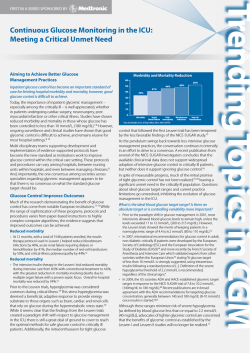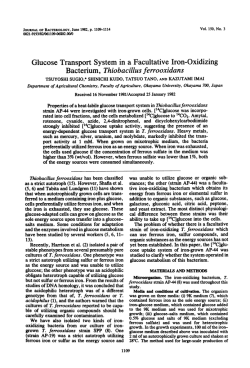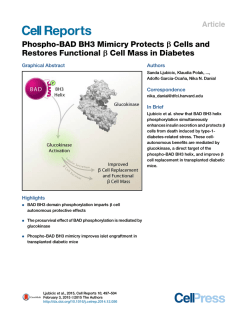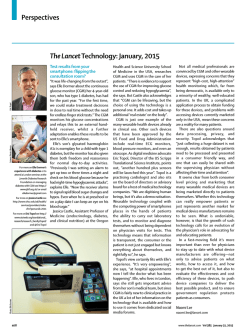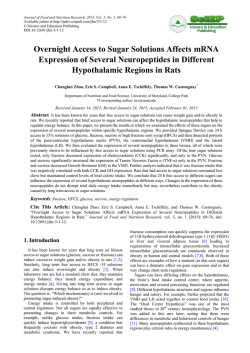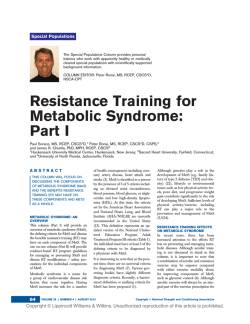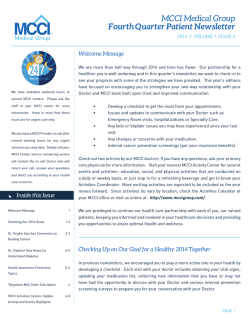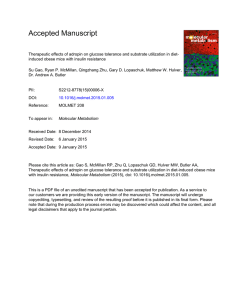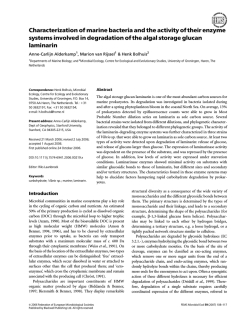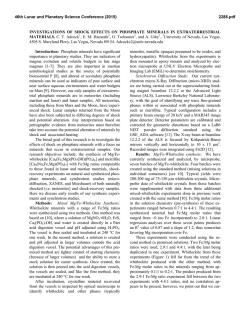
GROWTH STIMULATING EFFECT OF AUTOCLAVED GLUCOSE
GROWTH STIMULATING EFFECT OF AUTOCLAVED GLUCOSE MEDIA
AND ITS RELATIONSHIP TO THE C02 REQUIREMENT OF
PROPIONIBACTERIA'
MARVIN F. FIELD AND HERMAN C. LICHSTEIN
Department of Bacteriology and Immunology, University of Minnesota, Minneapolis, Minnesota
Received for publication May 19, 1958
485
Downloaded from http://jb.asm.org/ on February 6, 2015 by guest
During the study of microbial nutrition it is not essential for this heat activation effect since
not uncommon to find that the initiation of carbohydrate-free media autoclaved for progrowth of certain bacterial species in chemically longed periods at the usual pH (6.7) or for short
defined media is delayed although the total crop periods at a more acid pH (5) produced similar
of cells after prolonged incubation may approxi- growth promoting properties.
mate that obtained with complex media. Studies
The present paper represents further studies on
with several genera of microorganisms have re- the properties of this heat activation effect with
vealed that a prolonged delay in growth initia- the conclusion that there is a relationship between
tion may occur when the organism is inoculated this phenomenon and the carbon dioxide requireinto media which have been sterilized by filtra- ment for growth initiation of propionibacteria
tion or autoclaved without carbohydrate. How- from small inocula.
ever, this delay in growth may be reduced or
MATERIALS AND METHODS
eliminated when the medium is sterilized in the
autoclave. Early references to this heat activaThe majority of experiments reported here
tion effect may be found in the work of Fulmer were performed with Propionibacterium freudenand Huesselmann (1927), Fulmer et al. (1931) and reichii strain ATCC 6207. In addition, the folOrla-Jensen (1933).
lowing were employed for purposes of comparison:
More recently the nature of this effect has been P. pentosaceum strain E214, from the collection
studied in a variety of microorganisms by several of Professor C. B. van Niel; P. pentosaceum
investigators. Thus, for example, studies with strain ATCC 4875; and P. petersonii strain
streptococci have been carried out by Smiley ATCC 4870. Stock cultures were maintained in a
et al. (1943) and by Rabinowitz and Snell (1947) complex medium consisting of 1 per cent each of
while investigations with lactobacilli have been yeast extract (Difco), casitone (Difco), and
reported by Snell et al. (1948), Snell and Lervis glucose, and 0.5 per cent K2HPO4 adjusted to
(1953), Rose et al. (1953), Ramsey and Lankford pH 6.7 to 6.9. The inoculum was prepared from a
(1956) and Rogers et al. (1953). Similar studies 48 hr culture grown at 30 C. The cells were
with species of the genus Bacillus were made by harvested by centrifugation, washed three times
Sergeant et al. (1957) and by Lankford et al. in sterile distilled water and diluted 1: 100 in the
(1957).
same menstruum. To each experimental tube was
In a recent report from this laboratory (Field added 0.5 ml of inoculum. The growth experiand Lichstein, 1957) it was shown that the growth ments were carried out employing the synthetic
of four strains of propionibacteria was delayed or medium of Delwiche (1950) at pH 6.7. In some
not initiated at all when small inocula were intro- experiments it was desirable to substitute a
duced into media where the glucose was added mixture of purified amino acids for the casamino
aseptically after autoclaving of the other medium acids (Difco) of the medium. The composition
constituents. Prompt growth resulted when glu- of this mixture, as listed by Haurowitz (1950), was
cose or other reducing sugar was autoclaved with later modified by the omission of cystine, tryptothe medium. Indeed added carbohydrate was phan and one-half the amount of glutamate and
leucine. The basal chemically defined medium
I This work was supported in part by a grant
from Eli Lilly and Company, and by a contract without glucose was dispensed in 5 ml amounts
between the Office of Naval Research, Depart- to standardized 150 by 16 mm culture tubes.
ment of the Navy and the University of Min- Glucose and other test reagents were added from
stock solutions either before or after the autonesota (NR 103-250).
486
FIELD AND LICHSTEIN
TABLE 1
Effect of autoclaving glucose and phosphate with
hydrolyzed casein or amino acids on the growth
of Propionibacterium freudenreichii
Ingredients Autoclaved with Glucose*
Growt4
Casein hydrolyzate .................
Phosphate ..........................
Phosphate
Phosphate
Phosphate
Phosphate
0
10
42
48
31
29
29
16
14
14
9
7
casein hydrolyzate.
glycine ...............
leucine ...............
histidine .............
glutamic acid
tryptophan ...........
+ cystine ...............
+ alanine ...............
+ tyrosine ..............
+ proline ...............
controll .039
Autoclaved glucose
Aseptic glucose controlt
........
*
Glucose, 2 per cent; phosphate and casein, 1
per cent; amino acids, 1 mg per ml.
t Optical density X 100 at 650 m,u.
$ Glucose added to complete medium either
prior to or after autoclaving.
TABLE 2
Adsorption and elution of growth stimulating
material(s) from autoclaved mixtures of
glucose, phosphate and glycine*
Growth
72 hrtat
Conditions
Autoclaved glucose control
Aseptic glucose control .............
84
3
Aseptic glucose + autoclaved GPGl
Aseptic glucose + GPGI filtrate§ ....
88
12
........
Treatment of Norite with:
HCl, 0.1 N.......................
NaOH, 0.1 N .....................
Ethanol, 10% ....................
Ethanol, 50% ....................
Ethanol, 90% ....................
Benzene ..........................
Petroleum ether ..................
* Test organism: Propionibacterium
0
34
6
49
29
0
0
freuden-
reichii.
t Optical density X 100 at 650 m,.
t GPGI = glucose, phosphate, glycine mixture.
§ GPGI filtrate = GPGI after treatment with
Norite A.
Other conditions as for table 1.
claving (10 min, 121 C) and the total volume,
including inoculum, was brought to 10 ml. The
tubes were incubated at 30 C and growth determined at desired intervals in a Coleman Junior
spectrophotometer at 650 m,u. Other conditions
are described under the appropriate experiment.
RESULTS AND DISCUSSION
Inasmuch as carbohydrates may undergo
numerous reactions when heated with culture
media, it seemed desirable to determine the
minimal medium components necessary for
optimum growth stimulation of P. freudenreichii.
To this end, glucose was autoclaved for 10 min
with the various ingredients of the culture medium at pH 6.7 either individually or in combinations, and added to Seitz filtered medium. Among
the mixtures tested only hydrolyzed casein or
glycine was active after autoclaving with phosphate salts and glucose (table 1). Of the other
amino acids studied, only leucine, histidine and
glutamic acid exhibited results approaching that
obtained with the autoclaved glucose control
(i. e., glucose autoclaved with complete medium).
It should be mentioned that the amount of stimulation was not related to the degree of
"browning" during autoclaving since alanine,
cystine, proline and tryptophan produced as
much darkening of the medium as glycine or
histidine. These results suggest that certain
amino acids may combine with glucose or one of
its degradation products to form growth promoting compounds, or that some amino acids
may catalyze reactions leading to the synthesis
of stimulatory factors. The partial activity of
N-D-glucosylglycine for P. freudenreichii (Field
and Lichstein, 1957) may be in keeping with the
first hypothesis. Generally, however, these results
correlate well with those of Rogers et al. (1953)
for Lactobacillus gayoni.
To study further the properties of the stimlulatory factor(s), the autoclaved mixture of glucose, phosphate salts and glycine (GPGl) was
treated with Norite A (10 g Norite per 100 ml
solution) on a rotary shaker at room temperature
for 45 to 60 min. The suspension was filtered
through Whatman no. 2 paper on a Buchner
funnel and the filtrate (GPGl filtrate) added to
aseptic glucose media. The results of such experiments (table 2) revealed that the bulk of the
stimulatory material was removed by treatment
with charcoal. Furthermore, it is manifest that a
considerable portion of the active material(s)
Downloaded from http://jb.asm.org/ on February 6, 2015 by guest
Phosphate +
Phosphate +
Phosphate +
Phosphate +
Phosphate +
Phosphate +
at
[VOL. 76
19581
GROWTH STIMULATION BY AUTOCLAVED GLUCOSE MEDIA
100u-
100
6
A
80
487
2so
60
-
60
40
-
340
20
-20
B
6
6
x
0
6
5
34,5
0
20
40
HOURS
60
80
0
20
40
HOURS
60
80
Figure 1. Effect of glycosylglycine and glycylasparagine on the growth of Propionibacterium
freudenreichii. A. Delwiche medium. B. Delwiche
medium modified by replacement of casein hydrolyzate with amino acids. Curve 1, glucose
added aseptically after autoclaving; curve 2,
same as 1 + 5 mg of glycylasparagine per ml of
medium; curve 3, same as 1 + 1 mg of glycylasparagine per ml of medium; curve 4, same as 1 + 5
mg of glucosylglycine per ml of medium; curve 5,
same as 1 + 1 mg of glucosylglycine per ml of
medium; curve 6, glucose autoclaved with medium.
We are indebted to Dr. D. Rogers for a gift of
glucosylglycine and glycylasparagine.
pound possessed only limited activity when
incorporated into the amino acid medium. It is
reasonable therefore to suggest that a factor(s)
present in acid hydrolyzed casein may contribute
to growth initiation of P. freudenreichii and may
also be important in the utilization of glucosylglycine and glycylasparagine by this organism.
During the course of these investigations, a
large number of compounds were tested for their
ability to replace the stimulation of growth provided by autoclaved glucose media. These materials were tested at various levels by addition to
aseptically added glucose media. Among these,
supplements of B vitamins, purines and pyrimidines, ornithine, creatine, pyruvate, Tween 80,
glutathione, cysteine, ascorbic acid and various
phosphorylated derivatives of glucose were without effect. Negative results were obtained also
for either aseptically added or autoclaved acetaldehyde, furfuraldehyde, benzaldehyde, glyoxyllic
acid and glycolic acid. Of interest, however, was
the finding (table 3) that carbon dioxide, sodium
bicarbonate, several dicarboxylic acids, asparagine, and glutamine were either partially or completely active in replacing the autoclaved glucose
effect for P. freudenreichii. Also included are data
demonstrating that the active replacement compounds, including glucosylglycine and glycylas-
Downloaded from http://jb.asm.org/ on February 6, 2015 by guest
could be eluted from the charcoal by treatment
with 50 per cent ethanol while lesser amounts
were recovered with 90 per cent ethanol or 0.1 N
NaOH. Treatment with benzene, petroleum ether
or dilute acid was without effect. It should be
noted that the acid and alkali eluates were neutralized to pH 6.7 and the solvents removed by
evaporation over a steam bath prior to their
incorporation into the growth media. Furthermore, although not recorded in the table, similar
results were obtained by using autoclaved mixtures of glucose, phosphate and hydrolyzed
casein.
As already noted, the autoclaved glucose
effect for propionibacteria can be duplicated by
other reducing sugars but not by nonreducing
carbohydrates (Field and Lichstein, 1957).
Further studies revealed that glyceraldehyde and
glycolaldehyde were from 5 to 10 times more active than glucose on a molar basis. For example,
the minimum concentration of glucose necessary
for maximum activity was found to be 0.03 M
while that for glycolaldehyde and glyceraldehyde
was 0.006 and 0.004 M, respectively.
Rogers (1957) has reported that glycyl-i.
asparagine was more active than glucosylglycine
when tested for growth-promoting effects on a
mutant of Escherichia coli. Earlier results from
this laboratory (Field and Lichstein, 1957) revealed that glucosylglycine replaced partially the
autoclaved glucose effect for P. freudenreichii.
However, this compound had no effect when
incorporated into media containing a mixture of
19 synthetic amino acids in place of the hydrolyzed casein. Furthermore, growth in the
amino acid medium was not equivalent to that
obtained with the hydrolyzed casein medium
even when autoclaved with glucose. Recently,
however, we have modified the amino acid mixture so that growth was equivalent to that obtained when hydrolyzed casein was present. It
seemed desirable therefore, to compare glucosylglycine and glycylasparagine in the modified
amino acid and casein hydrolyzate media. In
agreement with previous results it was found that
glucosylglycine exhibited definite activity when
incorporated into the usual medium containing
hydrolyzed casein but was without effect in the
chemically defined medium (figure 1). On the
other hand, glycylasparagine replaced completely
the requirement for autoclaving with glucose
when added to the casein hydrolyzate medium in
appropriate concentration. However, this com-
.nn _
FIELD AND LICHSTEIN
488
TABLE 3
Effect of carbon dioxide and carbon dioxide
replacement compounds on the growth
of propionibacteria
Growth at 72 hr.*
Conc
P. P P
Additions to Aseptic Glucose
680rConcdfreu(10%%
n8 tepeMedium
(10
den-
ts-tosa-
rei-
s
chi' ceum ceum
620 E2 14 4875 487
Carbon dioxide (10%)
68
0
70
29
38
19
76
88
86
54
0
0
1.0
1.0
1.0
1.0
Asparagine .............. 0.1
Glutamine .............. 1.0
Glycyl-L-asparagine ..... 5.0
N-D-Glucosylglycine ..... 5.0
1.0
Aspartic acid....
Glutamic acid ........... 1.0
None (aseptic glucose
control) . .2
None (autoclaved glu64
cose control)
Sodium bicarbonate .....
Succinic acid ............
a-Ketoglutaric acid ......
Malic acid ..............
*Optical density
X 100 at 650
85
85
80
42
49
23
90
26
28
13
78
6
26
3
78
85
74
86
48
82
24
18
3
0
90 82
76
m/A..
TABLE 4
Effect of pH on the utilization of dicarboxylic acids
by Propionibacterium freudenreichii
Additions to Aseptic Glucose Conc
Medium
Growth at 72 hr.*
pH 6.8 pH 6.4 pH 6.0
mg/mli
Succinic acid
1.0
0.1
0.01
30
11
3
49
24
10
67
41
21
Malic acid
1.0
0.1
0.01
19
1
0
40
11
5
59
42
27
a-Ketoglutaric acid
1.0
0.1
0.01
42
2
78
42
0
67
16
9
0
3
18
58
60
62
None (aseptic glucose
control)
None (autoclaved glucose control)
*Optical density X
100 at 650 mMA.
26
paragine, were active for the three other strains
of propionibacteria employed. The results reported here suggest that the autoclaving of glucose with the medium produces a factor(s) which
satisfies the carbon dioxide requirement of propionibacteria for early initiation of growth.
Furthermore, metabolic experiments with resting
cells of P. freudenreichii resulted in evolution of
carbon dioxide from each of the active replacement compounds. Thus, these materials may act
either as a source of carbon dioxide or as an end
product of carbon dioxide fixation. It is noteworthy, however, that supplements of aspartate
and glutamate, which are well known carbon
dioxide replacement compounds for some microorganisms (Ajl and Werkman, 1948), were inactive for P. freudenreichii.
It is pertinent that pH had a marked effect on
the ability of the dicarboxylic acids to replace the
growth promoting effect of autoclaved glucose
medium. Results with succinate, malate and
a-ketoglutarate (table 4) revealed that their activity increased markedly as the growth pH became more acid. At a concentration of 1 mg per
ml of medium and at a pH of 6 these acids replaced completely the stimulating effect of autoclaved glucose media. Although not studied in
propionibacteria, such results suggest that the
penetration of dicarboxylic acids into the bacterial cells is improved by acid pH.
The stimulating effect of asparagine and glutamine already noted (table 3) was of interest since
these compounds are not infrequently interchangeable in the nutrition of some microorganisms. However, in the case of P. freudenreichii
titration revealed a marked difference in the
effectiveness of these compounds. In general 4 ,ug
of asparagine per ml of medium replaced completely the autoclaved glucose effect while 500
,ug of glutamine per ml of medium was required to
produce a similar effect. Of interest was the
finding that washed cell suspensions of P. freudenreichii produced CO2 from asparagine at a
rate at least ten times greater than from glutamine when studied at pH 6.
One goal of these studies was to define as completely as possible the nutritional requirements
for optimal growth of propionibacteria from
small inocula. On the basis of the experimental
findings described, it seemed desirable therefore
to determine the effect of CO2 and CO2 replace-
Downloaded from http://jb.asm.org/ on February 6, 2015 by guest
Nitrogen (10%)
[VOL. 76
GROWTH STIMULATION BY AUTOCLAVED GLUCOSE MEDIA
19581
4
80k
3-
602
0
0
x
c 40
0
201
0 20
80
Figure 2. Effect of carbon dioxide and asparagine on the growth of Propionibacterirni
freudenreichii in a chemically defined medium.
Curve 1, glucose added aseptically after autoclaving; curve 2, same as 1 + 1 mg of asparagine
per ml of medium; curve 3, same as I + 10 per cent
C02; curve 4, glucose autoclaved with medium.
ment compounds in the chemically defined
medium containing synthetic amino acids in
place of hydrolyzed casein. The data given in
figure 2 reveal that incubation in the presence
of 10 per cent CO2 resulted in growth comparable
to that obtained in the autoclaved glucose medium. Asparagine was definitely active but decidedly less so than CO2 and the addition of higher
concentrations did not improve the results. Although not given in the figure, the other CO2
replacement compounds were somewhat less
active than asparagine. It seems quite clear,
therefore, that optimal growth of P. freudenreichii from small inocula can be accomplished in
a defined medium without autoclaved carbohydrate by incubation in an atmosphere of 10 per
cent C02.
SUNIMARY
Previous results from this laboratory established that the growth of four strains of propionibacteria is stimulated markedly when glucose or
other reducing sugars are autoclaved with the
chemically defined culture medium. Further
investigations revealed that optimum stimulation occurred when glucose was autoclaved with
a mixture of phosphate salts and the caseini
hydrolyzate of the medium. Heated mixtures of
glucose and phosphates occasionally produced
partial activity. Several single amino acids were
active when autoclaved with the glucose-phosphate mixture, glycine being the most effective.
The active factor(s) could be adsorbed from the
heated amino acid-glucose-phosphate mixtures
with Norite A and at least part of the activity recovered from the charcoal with 50 per cent
ethanol. A number of compounds were tested for
their ability to replace the growth stimulation of
autoclaved carbohydrate media. Of these, only
N-D-glucosylglycine, glycyl-L-asparagine, several
dicarboxylic acids, asparagine and carbon dioxide
were active. It is suggested that reducing carbohydrates such as glucose react with phosphates
and amino acids during heating to produce a
factor(s) which replaces the carbon dioxide required for initiation of growth from small inocula.
REFERENCES
AJL, S. J. AND WERKMAN, C. H. 1948 Replacement of carbon dioxide in heterotrophic metabolism. Arch. Biochem., 19, 483-492.
DELWICHE, E. A. 1950 A biotin fuinctioni in succinic acid decarboxylation by Propionibacteriiun pentosaceurm. J. Bacteriol., 59, 439442.
FIELD, M. F. AND LICHSTEIN, H. C. 1957 Factors
affecting the growth of propionibacteria. J.
Bacteriol., 73, 96-99.
FULMER, E. I. AND HUESSELMANN, B. 1927 The
production of a yeast growth stimulant by
heating media under pressure. Iowa State
Coll. J. Sci., B, 1, 411-417.
FULMER, E. I., WILLIAMS, A. L. AND WERKMAN,
C. H. 1931 The effect of sterilization of
media uipon their growth promoting properties toward bacteria. J. Bacteriol., 21, 299303.
HAT ROWITZ, F. 1950 Chetistry and biology of
proteins. Academic Press, Inc., New York.
LANKFORD, C. E., KUSTOFF, T. Y. AND SERGEANT,
T. P. 1957 Chelating agents in growth
initiation of Bacillbs globigii. J. Bacteriol.,
74, 737-748.
()RLA-JENSEN, A. D. 1933 Hitherto unknownr
activators for the growth of lactic acid bacteria. J. Soc. Chem. Ind. (London), 52, 374379.
I{ABINOWITZ, J. C. AND SNELL, E. E. 1947 The
vitamin B6 group. XI. An improved method
for assay of vitamin B6 with S. faecalis. J.
Biol. Chem., 169, 631-642.
RAMSEY, H.H. AND LANKFORD, C. E. 1956,
Stimulation of growth initiation by heat degradation products of gluicose. J. Baeteriol.
72, 511-518.
Downloaded from http://jb.asm.org/ on February 6, 2015 by guest
40
60
HOURS
489
490
FIELD AND LICHSTEIN
D.
1957 (Glucosylglycine and(l the metabolism of asparagine and glutamine by
Escherichia coli. Bacteriol. Proc., 1957, 119.
ROGERS, 1)., KING, T. E. AND CHELDELIN, V. H.
1953 Growth stimulation of Lactobacilluis
gayoni by N-D-glucosylglycine. Proc. Soc.
Exptl. Biol. Med., 82, 140-144.
ROSE, C. S., FELDBAUM, E. P., NORRIS, R. F., AND
GYORGY, P. 1953 Toxicity of autoclaved
cystine for Lactobacillus bifidus. Proc. Soc.
Exptl. Biol. Med., 81, 709-712.
SERGEANT, T. P., LANKFORD, G. E., AND TRAXLER,
R. W. 1957 Initiation of growth of bacillus
RtOGERS,
[VOL. 76
a chemically (lefined mediuIll. J.
Bacteriol., 74, 728-736.
SMIILEY, K. L., NIVEN, C. F., JR., ANI) SHERMIAN,
J. M. 1943 The nutrition of Streptococcus
salivariuis. J. Bacteriol., 45, 445-454.
SNELL, E. E., KITAY, E., AND HOFF-JORGENSEN, E.
1948 Carbohydrate utilization by a strain of
Lactobacilluis balgaricus. Arch. Biochem., 18,
495-510.
SNELL, N. ANI) LERVIS, J. C. 1953 Nuitritional
studies with Lactobacillus fermenti. J. BaCteriol., 65, 671-677.
species in
Downloaded from http://jb.asm.org/ on February 6, 2015 by guest
© Copyright 2026
